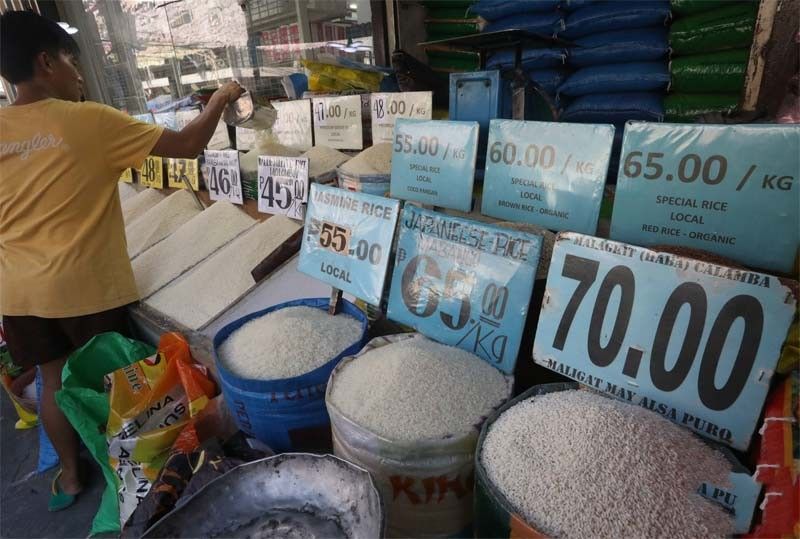Rice inventory down 26.5 percent

But Marcos sees stable prices as harvest begins
MANILA, Philippines — The country’s rice inventory continued to decline, dropping by 26.5 percent in April, according to data from the Philippine Statistics Authority (PSA).
President Marcos, however, said rice prices in the country are expected to stabilize as harvest in major palay-producing regions has started.
In its latest rice and corn stocks inventory report, the PSA said total rice stocks inventory stood at 1.84 million metric tons as of April 1, lower than the 2.51 million MT registered in the same period a year ago.
In contrast, the current inventory is 30.8 percent higher than the 1.41 million MT registered the previous month.
Households accounted for the bulk of the inventory or 55.1 percent at 1.015 million MT, followed by commercial warehouses with a 39.3 percent share at 728,730 MT, while supplies from the National Food Authority (NFA) depositories cornered a 5.4 percent share at 99,030 MT.
Compared to the previous year’s level, rice stocks in households declined by 26 percent.
Rice stocks in commercial warehouses also declined by 26.9 percent.
In contrast, stocks in NFA depositories decreased by 27.1 percent.
On a monthly basis, rice stocks in households increased by 25.1 percent.
Stocks in NFA depositories also increased by 47.1 percent, while stocks in commercial warehouses posted a 3.9 percent month-on-month decrease.
Meanwhile, the country’s corn stocks inventory declined 36.1 percent to 469,740 MT from 777,370 MT as of April 1.
On a monthly basis, corn inventory increased by 41.1 percent from the previous month’s 352,040 MT.
Corn stocks in commercial warehouses accounted for the bulk of the inventory or 79.3 percent at 393,850 MT, while households accounted for 20.7 percent of the total inventory at 102,880 MT.
Compared to the previous year’s level, corn stocks in commercial warehouses declined by 42.8 percent, while stocks in households declined by 34.1 percent.
On a monthly basis, corn stocks in commercial warehouses increased by 7.2 percent while stocks in households increased by 53.8 percent.
Prices to stabilize
Rice prices in the country are expected to stabilize as harvest in major palay-producing regions started, President Marcos said on Thursday.
Marcos, who is also agriculture secretary, said palay harvest has commenced in Nueva Ecija, Isabela and North Cotabato, which are expected to augment the country’s supply of the staple.
He also said the Department of Agriculture (DA) and the Department of Trade and Industry are closely monitoring the supply and prices of rice in the market as well as the farmgate price and importation, which he said contributed to the increasing prices.
“We are closely monitoring our rice supply and keeping an eye on rising rice prices,” the President said in a video message posted on Facebook.
DA Undersecretary for rice industry development Leo Sebastian, meanwhile, said initial palay harvest from Isabela, Nueva Ecija and North Cotabato produced around 900,000 MT.
“Palay harvest will peak in late September to October, contributing largely to the country’s second semester (July to December) production, estimated at more than 11 million metric tons (MMT),” he said.
Barring strong typhoons in the coming months that may adversely affect Central and Northern Luzon, Sebastian said the DA is aiming to harvest up to 11.5 MMT in the second semester of the year.
“This would breach the 20 MMT total national palay production, making it a record, being the highest in the country’s history,” he said.
Based on monitoring of the DA, the retail price of local regular milled rice is as high as P50 per kilo; local well-milled rice, P52 per kilo; local premium rice, P56 per kilo and local special rice, P60 per kilo, while imported rice is sold as high as P65 per kilo.
Tarifficaion review
Sen. Imee Marcos yesterday supported a review of the Rice Tariffication Law (RTL) or Republic Act 11203 to bring back the regulatory powers of the NFA. The RTL removed the various regulatory powers of the NFA, from import licensing to warehouse inspection.
Marcos said the current RTL needs to be amended to look into the clipping of NFA’s regulatory powers that allowed the private sector to import rice.
“The problem is we need to assert the power of regulation instead of surrendering it,” the senator said in Filipino in an interview during her visit in Cagayan on Friday, as reported by dzRH. “Let us not keep on importing. Let us put local producers first if necessary, especially now that their produce has been destroyed (by recent typhoons).”
President Marcos had ordered a review of the 2019 law, which deregulated rice imports subject to tariffs.
The RTL did not benefit both the consumers and the farmers since its passage in 2019, former agriculture secretary and Federation of Free Farmers (FFF) board chairman Leonardo Montemayor said yesterday.
“The FFF welcomes the incumbent administration’s long-overdue recognition of the serious infirmities in the Rice Tariffication Law. Essentially, RTL has left food security and farmers’ and consumers’ welfare to the vagaries of the so-called free market and the ‘humanitarian’ graces of rice-exporting countries,” Montemayor told The STAR.
In a separate radio interview, Montemayor added that under the RTL, the importation of rice was left to the importers. He noted that from P38 per kilo prior to the passage of the RTL, the retail prices of rice reached as high as P60 per kilo.
Buy palay from far-flung areas
Farmer’s group Samahang Industriya ng Agrikultura (SINAG) is urging the NFA to procure their palay stocks from far-flung areas where farmgate prices are lower than the government-support price of P19 per kilo.
SINAG president Rosendo So said many far-flung provinces in the country have been selling rice crops priced lower than the NFA buying price of P19 per kilo. These areas, listed on the records of the PSA, should be given priority by the NFA in its buffer stocking program, So pointed out.
He reminded NFA officials that they cannot use the untouched P8.5-billion palay procurement fund and pointed out that his group will not hesitate to file charges of diversion of funds if the grain agency procures Indian rice for building its buffer stocks.
On the other hand, FFF national manager believed that NFA administrator Robert Bioco “went to India to ask for a quota from India that would be exempted from their ban. The quota would then be allocated to local importers.”
Malou Tolentino, a rice trader and Bulacan coordinator of the Philippine Rice Industry Stakeholders Movement, said they are not sure what the agenda of Bioco is in India.
She added that Bulacan rice traders have no objections if the government raises the NFA’s palay procurement price to P22 to P25 per kilo since this will benefit the local farmers.
“Palay traders would just have to adjust their palay buying price to be competitive with the NFA in its palay procurement program,” she said. — Bella Cariaso, Ramon Efren Lazaro, Marc Jayson Cayabyab
- Latest
- Trending
































